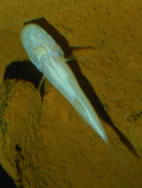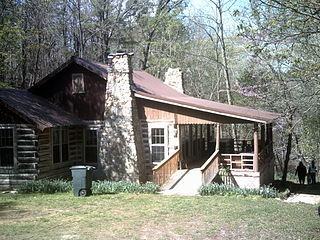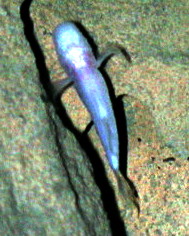The northern cavefish or northern blindfish is found in caves through Kentucky and southern Indiana. It is under review for possible listing under the Endangered Species Act of 1973 in the United States as of 2023, and the IUCN lists the species as near threatened.

The Mexican tetra, also known as the blind cave fish, blind cave characin, and blind cave tetra, is a freshwater fish of the family Characidae of the order Characiformes. The type species of its genus, it is native to the Nearctic realm, originating in the lower Rio Grande and the Neueces and Pecos Rivers in Texas, as well as the central and eastern parts of Mexico.
The Percopsiformes are a small order of ray-finned fishes, comprising the trout-perch and its allies. It contains just ten extant species, grouped into seven genera and three families. Five of these genera are monotypic.

The Amblyopsidae are a fish family commonly referred to as cavefish, blindfish, or swampfish. They are small freshwater fish found in the dark environments of caves, springs and swamps in the eastern half of the United States. Like other troglobites, most amblyopsids exhibit adaptations to these dark environments, including the lack of functional eyes and the absence of pigmentation. More than 200 species of cavefishes are known, but only six of these are in the family Amblyopsidae. One of these, Forbesichthys agassizii, spends time both underground and aboveground. A seventh species in this family, Chologaster cornuta, is not a cave-dweller but lives in aboveground swamps.

The Ozarks, also known as the Ozark Mountains, Ozark Highlands or Ozark Plateau, is a physiographic region in the U.S. states of Missouri, Arkansas, Oklahoma and the extreme southeastern corner of Kansas. The Ozarks cover a significant portion of northern Arkansas and most of the southern half of Missouri, extending from Interstate 40 in central Arkansas to Interstate 70 in central Missouri.

The Alabama cave shrimp is a species of shrimp in the family Atyidae, found only in caves in the state of Alabama.

The Ozark cavefish, Amblyopsis rosae, is a small subterranean freshwater fish endemic to the United States. It has been listed as a threatened species in the US since 1984; the IUCN currently lists the species as Near Threatened, though it was previously listed as Vulnerable between 1986 and 1996. It is listed as Endangered and Threatened by the Missouri Department of Conservation.
The golden cave catfish is a critically endangered species of airbreathing catfish. This cavefish is only known to live in the Aigamas cave, Otjozondjupa region, Namibia. It has also been reported from the nearby Dragon's Breath Cave, but this is an error. The golden cave catfish lack pigmentation and are up to 16.1 cm in standard length. They have very small eyes that are covered with skin, and are probably effectively blind. They feed on detritus and invertebrates that fall into the lake in which they live. The population is estimated at 200–400 individuals. Little is known about its reproduction, and attempts to breed it in captivity have failed. The population is threatened by chance events and water extraction from the cave lake, which has resulted in a drop of the water level.

The Alabama cavefish is a critically endangered species of amblyopsid cavefish found only in underground pools in Key Cave, located in northwestern Alabama, United States in the Key Cave National Wildlife Refuge. It was discovered underneath a colony of gray bats in 1967 by researchers Robert A. Kuehne and John E. Cooper and scientifically described in 1974.
Fern Cave National Wildlife Refuge is a 199-acre (0.8 km2) National Wildlife Refuge located in northeastern Alabama, near Paint Rock, Alabama in Jackson County.
The spring cavefish is the only member of the genus Forbesichthys and is one of seven species in the family Amblyopsidae. This species is listed as state endangered in Missouri, but it is considered to be of least concern by the IUCN Red List due to its relatively large population size and number of subpopulations. The spring cavefish inhabits caves, springs, spring runs, and spring seeps. It is subterranean, emerging at dusk and retreating underground an hour or two before dawn. The species is located within areas of the central and southeastern United States. It stays underground after dawn, but then emerges into surface waters at dusk. They are a carnivorous fish and are well adapted to their environment. The species' breeding behavior is rarely documented. Spawning occurs underground and in darkness between January and April. The status and distribution of cave-obligate species is incomplete or lacking entirely, which makes conservation and management decisions difficult. Kentucky and Missouri are the two main states that have their agencies managing this species in some way.
A blind fish is a fish without functional eyes. Most blind fish species are found in dark habitats such as the deep ocean, deep river channels and underground.
Caecobarbus geertsi, the African blind barb or Congo blind barb, is a species of cyprinid fish. This threatened cavefish is only known from Democratic Republic of the Congo, and it is the only member of the monotypic genus Caecobarbus. George Albert Boulenger described this fish in 1921 and it apparently lacks any close relatives in the Congo region.

Cavefish or cave fish is a generic term for fresh and brackish water fish adapted to life in caves and other underground habitats. Related terms are subterranean fish, troglomorphic fish, troglobitic fish, stygobitic fish, phreatic fish and hypogean fish.

Originally known as the Oklahoma Bat Caves National Wildlife Refuge, Ozark Plateau National Wildlife Refuge was established for the protection of endangered bats and their habitat. The refuge is made up of several parcels of land located in northeastern Oklahoma. These parcels contain numerous caves considered crucial for the bats' survival.

Amblyopsis is a genus of small fish in the family Amblyopsidae that are endemic to the central and eastern United States. Like other cavefish, they lack pigmentation and are blind. The most recently described species was in 2014. Uniquely among fish, Amblyopsis brood their eggs in the gill chambers. It was formerly incorrectly speculated that the same brooding behavior existed in other genera in the family and in the pirate perch. During the Pleistocene period, the modern Ohio river was a barrier of dispersal and created a great genetic variation, leading to two phylogenetically distinct lineages from the species Amblyopsis.

The Hoosier cavefish is a subterranean species of blind fish from southern Indiana in the United States. Described in 2014, A. hoosieri was the first new species of amblyopsid cavefish to be discovered in 40 years.

Prosanta Chakrabarty is an American ichthyologist and professor of ichthyology, evolution and systematics at Louisiana State University. He studied at McGill University where he received a bachelor of science in Applied Zoology and at the University of Michigan where he obtained his PhD in Ecology and Evolution. Among other professional positions he was a Program Director for the National Science Foundation and is currently the President-Elect of the American Society of Ichthyologist and Herpetologist. He was named a TED Fellow in 2016, and a TED Senior Fellow in 2018. He was named an Elected Fellow of the AAAS for "distinguished contributions to evolutionary biology, focusing on the bioluminescent systems and historical biogeography of freshwater fishes, and for effectively communicating science to the public."










